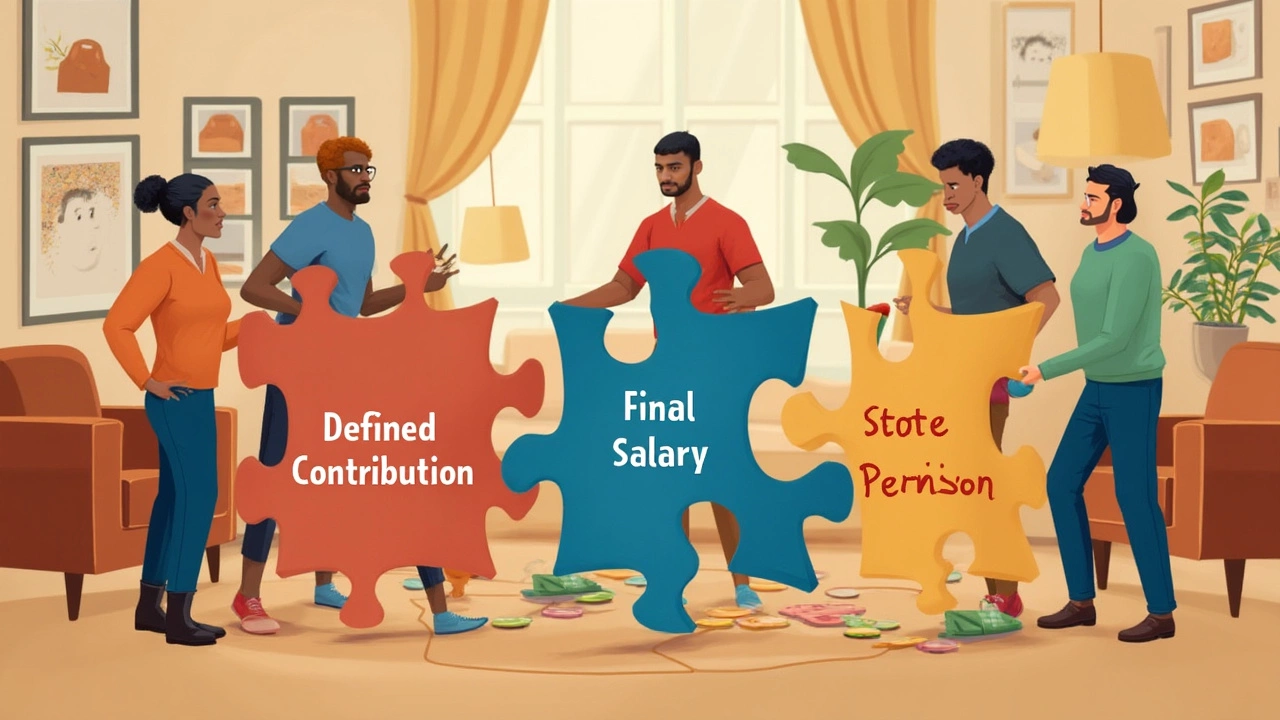Pension Planning: What Happens to Your Pension if You Quit?
 May, 28 2025
May, 28 2025
If you’re thinking about quitting your job, the first question you probably ask yourself is, “Will I lose my pension?” It’s a fair worry. After all, nobody wants to see years of savings just disappear. The good news? In most cases, your money doesn’t just vanish—but the details can get tricky depending on your plan.
Some jobs give you a pension that kicks in at retirement, others put money into a pot over time. The rules for what happens next all depend on the type of pension you have. Walk away too soon, and you might not be able to grab every penny. Stick around just long enough, and you could get the whole pie. It’s all in the fine print—vesting periods, contribution rules, and transfer options.
Ready to find out how to make sure your pension is safe when you quit? Let’s break down what really happens, so you’re not caught off guard and can walk away on your own terms.
- How Different Pension Plans Handle Quitting
- What Happens to Your Contributions
- Moving or Cashing Out Your Pension
- Smart Moves to Protect Your Retirement Savings
How Different Pension Plans Handle Quitting
Pension plans are not all cut from the same cloth. What happens to your money when you quit your job really depends on the type of plan you have. Most folks deal with one of two main types: defined benefit plans (like old-school pensions) and defined contribution plans (like 401(k)s). Understanding how each one works helps you protect your savings when moving on.
Pension plans that promise you a fixed payment for life after you retire are called defined benefit plans. If you quit before you’re "vested" (that’s a fancy word for owning your benefit), you’re usually out of luck—most jobs require you to work several years before any of it is yours. But once you hit that vesting milestone, whatever you’ve earned is locked in, even if you leave. The exact timing varies by employer, but a common rule is five years.
| Pension Type | Vesting Period | What Happens If You Quit Early | What Happens If Fully Vested |
|---|---|---|---|
| Defined Benefit (e.g. traditional pension) | Usually 3-7 years | Lose employer-funded benefit | Keep benefit, get payout at retirement age |
| Defined Contribution (e.g. 401(k)) | Immediate to 6 years (depends on employer) | Keep your own contributions, may lose some employer match | Keep everything, can rollover or withdraw (with penalties) |
Then there are defined contribution plans, like the ever-popular 401(k). Here, both you and your employer throw money into the pot. Whatever you put in is always yours, no matter when you leave. The catch is with the employer match. There’s usually another vesting schedule—so if you walk out the door too soon, you might forfeit the company’s contributions but still keep every dollar you chipped in.
Tip: Check your plan documents (or just shoot HR an email). The rules and timelines can be wildly different between companies. I’ve even seen friends lose out on thousands just for quitting a month before reaching their vesting date. Ouch.
Some jobs (like government gigs) have their own setups, with stricter rules—or surprising flexibility. For example, public sector pensions can have longer vesting periods, but they often offer portability across different agencies, letting you keep growing your benefit if you switch jobs within the system.
What Happens to Your Contributions
The big question is: once you leave your job, who keeps the money in your pension— you or your company? Let’s set the record straight. If you’ve been putting part of your paycheck into your workplace pension, that money is yours, no matter when you quit. It doesn’t boomerang back to your boss.
But here’s where it gets tricky: employer contributions aren’t always a sure thing. Most companies use something called a vesting schedule. Think of it as a loyalty test. If you stick around long enough to hit the vesting period—usually three to five years—then you walk away with all the money your employer put in.
| Type of Contribution | What Happens If You Quit |
|---|---|
| Your contributions | You keep 100%, always. |
| Employer contributions (unvested) | You lose them if you leave before vesting period. |
| Employer contributions (vested) | You keep 100%, just like your own. |
Let’s say you had a 401(k) and the company matched your contributions. If you’re not “vested” yet, the employer’s part could go back to the company if you leave. If you are, you keep it. It’s like hitting a game checkpoint—you don’t want to leave too soon and lose progress.
Every plan is different, but a 2023 report from Vanguard showed about 54% of 401(k) plans use immediate vesting for employee contributions, while employer matches often require three years of service for full vesting.
"You always have a right to your own contributions. But to keep all of your employer’s contributions, you’ll usually need to meet your plan’s vesting rules." — U.S. Department of Labor
- Pension plans from old-school jobs (think teachers, firefighters) usually have longer vesting rules. These often need five years of service for you to get any employer-funded benefit.
- Modern-day 401(k)s are more flexible, but watch out for those employer vesting schedules—read the fine print before you hand in your notice.
The bottom line? Take time to check your plan details before making any moves. You could be just months away from snagging thousands more in employer cash. Double-check, or you might leave money on the table.

Moving or Cashing Out Your Pension
If you’re switching jobs, you might wonder if you can take your pension with you. The short answer: usually yes, but how you do it matters a lot. With most employer plans, you have a couple of clear options—move your savings to a new retirement plan or cash out. Both come with pros, cons, and some rules you can’t ignore.
The most common move is rolling your pension into another retirement account, like an IRA or your new job’s plan. This way, your money keeps growing, and you avoid a massive tax bill. It’s called a “direct rollover.” The best part? You don’t touch the money, so Uncle Sam doesn’t see it as income, and you keep your retirement on track.
- Pension cash-outs are tempting but full of pitfalls. If you’re under 59½, expect a 10% early withdrawal penalty on top of regular income tax. That means you could easily lose a big chunk right off the bat.
- Some pensions force you to take your money when you quit if your balance is small (often less than $5,000). Don’t just pocket the check—roll it over if you can, or you’ll face the tax hit.
- If you’re in a defined benefit plan (those traditional pensions that promise a paycheck for life), money usually stays put until retirement age. You might have the option to take a lump sum, but it’s smart to check the numbers first—sometimes staying in the plan offers a better deal long-term.
One more tip: always double-check the rules with your HR or plan provider before making any decisions. Every plan has its own process, and missing a step can cost you in taxes or lost savings opportunities. Take a day or two to line up your next move—the effort is worth it to keep your future secure.
Smart Moves to Protect Your Retirement Savings
So you’re leaving your job and staring at your pension statement, wondering what to do next. It’s not just about taking the cash and running. The choices you make now can seriously shape your financial future, especially if you’re planning a long career with several job changes.
First, don’t rush to cash out your pension. Sure, that lump sum looks tempting, but pulling money early usually means paying heavy taxes and sometimes penalties. Plus, you lose out on the growth that comes with leaving your savings invested for retirement. According to the IRS, early distributions from a traditional 401(k) or similar plan before age 59½ can trigger an extra 10% penalty on top of regular taxes.
The better move? Think about rolling your pension over into a new employer’s plan or an IRA (Individual Retirement Account). Rolling over your pension keeps your savings growing, avoids early withdrawal penalties, and gives you more control. You just have to make sure the money goes straight from the old plan to the new one—don’t take the distribution check yourself. This is called a direct rollover and keeps your retirement savings sheltered from immediate taxes.
Check your vesting status before you quit. If you’re close to being fully vested, it might be worth sticking it out a few months longer so you don’t miss out on employer contributions. Vesting schedules can vary; some companies make you wait three years, others five. Double-check your plan’s rules—they’re usually spelled out in your annual pension statement or you can ask your HR rep.
Always track your account. If you have pensions with past employers, keep those statements and update your contact info. Lost accounts are more common than you might think—there’s over $1 billion in forgotten retirement money sitting in the U.S. alone, according to the Government Accountability Office.
- Don’t leave your personal details outdated—otherwise you might miss important paperwork or checks.
- If you move jobs often, consider consolidating all your old pensions into one IRA for easier tracking.
- Review your investment options in your new plan or IRA, so your money keeps working toward your goals.
Finally, talk to a tax advisor or financial planner if you’re unsure. Serena always says, it’s better to spend an hour figuring things out now than to regret it decades later. A little effort today can save you a lot down the road.
